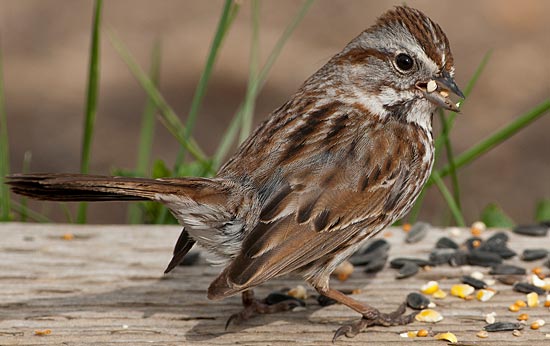Bird ID Help: Tackling Tricky Sparrows
By Jessie Barry
October 15, 2012
Date: October 17
Location: Suburban Backyard, Philadelphia, Pennsylvania
Imagine you’re sipping coffee on your back porch when a different kind of sparrow pops out from under a bush, jostling with your regular House Sparrows for spilled seed under the bird feeder. What is that?
You could flip to your trusty field guide, but you know that half of the little birds in the book are brown, so you’re tempted to just chalk it up as a “little brown jobber.” But, with three easy steps, you can narrow the list of possibilities for this little sparrow and zero in on a positive ID.
Step 1: Take Notes
Don’t rush off to the guide just yet; take two minutes to watch the bird. Write down a short description of the bird and what it’s doing. The more information the better, but it doesn’t need to be elaborate. Focus on shape, color pattern, behavior, and habitat. Compare it with the House Sparrows. Is it bigger or smaller? How does the shape compare—longer tailed, shorter tailed? What is the overall color of the bird? What is the color and pattern of the head? Are there streaks on the breast? Don’t forget to note the behavior: it’s scratching around on the ground, which rules out finches.
Step 2: Use eBird
Go to eBird.org to find out what sparrow species are near you in mid-October. eBird is an amazing resource of more than 100 million bird observations. Click on the “Explore Data” tab, then click on “Bar Charts.” Select your state and county from the menu. A list of all the species reported appears. In all likelihood your species will be on this list. Now take a look at the green bars themselves, which give an indication of seasonal occurrence. The wider the bar, the more likely it is a match to your bird. Look for the species with thicker green bars for this date. The narrower the bar, the less likely it is that you are seeing that species. It is very unlikely the species you are looking at has never been reported before.
Step 3: Use your notes
Ok, now using this short list of likely birds, your field notes, and ID resources (field guide or online resource, such as allaboutbirds.org), look for a match. When it comes to sparrows you can get lost in all the species, so start with those that are most likely according to eBird. Hopefully, you will be able to find a species that is likely to occur and matches the field marks in your notes.
Learning to identify birds is a process. It takes time to learn what to look for. Sparrows are a great group to practice with because they force you to look carefully. Good luck this fall as sparrows are on the move and settling into their wintering grounds—it’s a great time to pick up a species you have not seen before, or seen but not identified.

All About Birds
is a free resource
Available for everyone,
funded by donors like you
American Kestrel by Blair Dudeck / Macaulay Library



